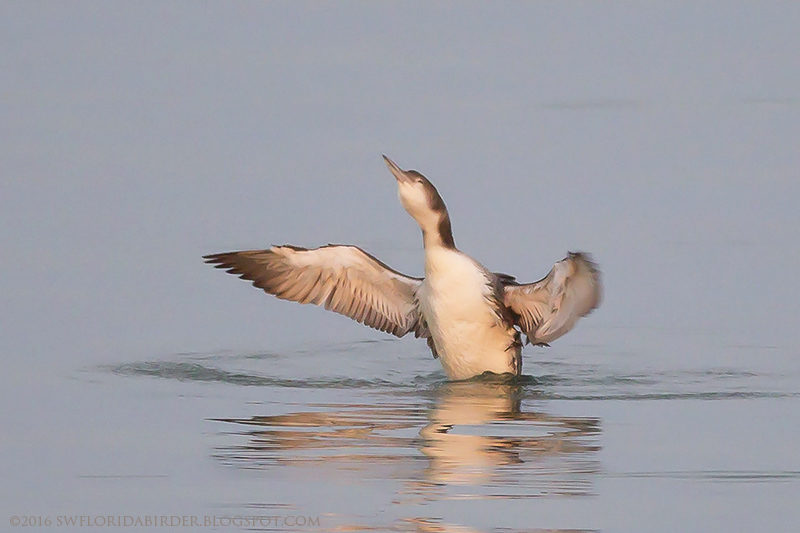A trek to Fort De Soto Park in Pinellas County is especially rewarding during migration season. Fort De Soto is a magnet for birds. In fact there have been 337 species sighted at the park and reported to eBird as of this writing.
Ron Smith has noted that a Western Grebe was observed and photographed by Marvin Waas in late 1954 which was the first and last time the species was seen in Pinellas County.
This sighting occurred about eight years before Fort De Soto Park opened to the public.
The Common Loon above (image 1) was photographed at Fort De Soto Park in April 2016.
The sunrise above (image 2) was photographed at Fort De Soto Park in April 2016.
The Brown-headed Cowbird above (image 3) was photographed at Fort De Soto Park in April 2016.
The Short-billed Dowitcher above (image 4) was photographed at Fort De Soto Park in April 2016.
The Least Sandpiper above (image 5) was photographed at Fort De Soto Park in April 2016.
The Willet above (image 6) was photographed at Fort De Soto Park in April 2016.
The Willet above (image 7) was photographed at Fort De Soto Park in April 2016.
The Willet above (image 8) was photographed at Fort De Soto Park in April 2016.
The Piping Plover above (image 9) was photographed at Fort De Soto Park in April 2016.
The Dunlin above (image 10) was photographed at Fort De Soto Park in April 2016.
Tom Obrock and I made a mid April journey to Fort De Soto Park to enjoy the semi-annual migratory spectacle. We had discussed alternate venues to visit in the event Fort De Soto was quiet, but they were not necessary as there was good bird activity resulting in a full day’s effort (including the four hour commute).
The Semipalmated Plover with Piping Plover above (image 11) was photographed at Fort De Soto Park in April 2016.
The Semipalmated Plover above (image 12) was photographed at Fort De Soto Park in April 2016.
The Black-bellied Plover above (image 13) was photographed at Fort De Soto Park in April 2016.
The Forster’s Tern above (image 14) was photographed at Fort De Soto Park in April 2016.
The Forster’s Tern above (image 15) was photographed at Fort De Soto Park in April 2016.
The Nanday Parakeet above (image 16) was photographed at Fort De Soto Park in April 2016.
The Nanday Parakeet above (image 17) was photographed at Fort De Soto Park in April 2016.
The Nanday Parakeet above (image 18) was photographed at Fort De Soto Park in April 2016.
The Nanday Parakeet above (image 19) was photographed at Fort De Soto Park in April 2016.
At the East Beach Turnaround there was some entertaining action as a pair of Willet seemed to be at odds with one another while a Piping Plover showed dominance over a Semipalmated Plover. While about a dozen Nanday Parakeet were observed at the entrance to the park, they would later congregate into a flock of 30 at East Beach. It was interesting to observe European Starling showing dominance over Nanday Parakeet here.
The Nanday Parakeet above (image 20) was photographed at Fort De Soto Park in April 2016.
The European Starling with Nanday Parakeet above (image 21) was photographed at Fort De Soto Park in April 2016.
The European Starling with Nanday Parakeet above (image 22) was photographed at Fort De Soto Park in April 2016.
The Nanday Parakeet above (image 23) was photographed at Fort De Soto Park in April 2016.
The Nanday Parakeet above (image 24) was photographed at Fort De Soto Park in April 2016.
The Nanday Parakeet above (image 25) was photographed at Fort De Soto Park in April 2016.
The Nanday Parakeet above (image 26) was photographed at Fort De Soto Park in April 2016.
The Nanday Parakeet above (image 27) was photographed at Fort De Soto Park in April 2016.
The Nanday Parakeet above (image 28) was photographed at Fort De Soto Park in April 2016.
A large flock of Cedar Waxwing was also active at mid-morning near the Bay Pier. They were making very quick work of the Mulberries that were in various stages of ripeness. A few warblers species were observed along the southern end of Mullet Key with a lone Hooded Warbler making a very brief appearance.
The Fish Crow above (image 29) was photographed at Fort De Soto Park in April 2016.
The Black-and-white Warbler above (image 30) was photographed at Fort De Soto Park in April 2016.
The Summer Tanager above (image 31) was photographed at Fort De Soto Park in April 2016.
The Cedar Waxwing above (image 32) was photographed at Fort De Soto Park in April 2016.
The Cedar Waxwing above (image 33) was photographed at Fort De Soto Park in April 2016.
Always reluctant to leave a productive area, our next stop at Fort De Soto Park would be North Beach.
The Cedar Waxwing above (image 34) was photographed at Fort De Soto Park in April 2016.
The Red-eyed Vireo above (image 35) was photographed at Fort De Soto Park in April 2016.
Please be sure to be reminded about this weekly Southwest Florida Wildlife Blog with the email gadget located at the top of the page.
The Red-eyed Vireo above (image 36) was photographed at Fort De Soto Park in April 2016.
Bob Pelkey
This blog is updated every Friday (preferably) and randomly, primarily on the subject of wildlife observation in the state of Florida. This blog is in conjunction with my secondary photo site at http://www.pbase.com/jkrnm5/




































Leave a Reply